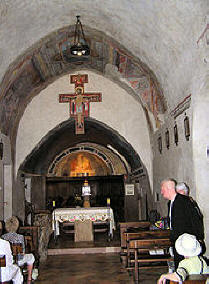|
Treasures of the Church- Holy Sites |
 San
damiano house
San
damiano house
by SCTJM
In 1205,
a young and restless Francesco was in this dilapidated old church
praying before a 12th-century painted crucifix. Suddenly, the Christ
on the crucifix came to life and spoke to Francis, saying, "Rebuild
my church which is falling into ruins.” Francis took the command
literally at first, reconstructing the little church with his own
hands. As time went one St. Francis understood that the Lord was
asking him to rebuild his church in the spiritual sense. San Damiano
became a favorite retreat place for Francis and his followers and it
was here that he wrote the first draft of the Canticle of the
Creatures.
St. Clare, a faithful follower of St. Francis, later moved to this
church of San Damiano, which St. Francis himself had rebuilt. Other
women joined her there, and San Damiano became the focal point for
St. Clare’s new religious order, which was known in her lifetime as
the “Order of San Damiano.” Just ten years after Clare's death, Pope
Urban IV officially changed the name to the Order of St. Clare.
They became known for living a radical and austere life of poverty,
penance, mortification, and prayer. Unlike the Franciscan friars,
whose members moved around the country to preach, Saint Clare’s
sisters lived in enclosure. St. Clare sought to imitate St. Francis’
virtues and way of life so much so that she was sometimes titled as
‘another Francis.’ She became a living copy of the poverty, the
humility, and the mortification of St. Francis. For a time the order
was directed by Francis himself. However, in 1216, St. Clare
accepted the role of abbess at San Damiano. She was abbess for over
forty years, until her death.
St. Clare also played a significant role in encouraging and aiding
St. Francis. It was to her that he turned to when in struggles of
doubt. When he was quite ill, St. Francis came for the last time to
visit San Damiano. St. Clare erected a little wattle hut for him in
an olive grove close to the monastery, and it was here that he
composed his famous “Canticle of the Sun.” After the death of St.
Francis the procession which accompanied his remains from the
Portiuncula to the town stopped on the way at San Damiano in order
that St. Clare and her daughters might venerate his pierced hands
and feet of his stigmata. However, so far as Clare was concerned,
St. Francis was always living, and nothing is really more striking
than her unswerving loyalty to the ideals of poverty, and the care
with which she clung to his rule and teaching.
There is no good reason to believe that St. Clare ever went beyond
the boundaries of San Damiano during all the time she was there. As
one could imagine, a lot of prayers and mortifications rose up from
this holyIt is related that once, while Francis was praying at the
Portiuncula, Christ appeared to him and offered him whatever favor
he might want. The salvation of souls was ever in St. Francis’
prayers, and wishing to make his beloved Portiuncula a sanctuary
where many might be saved, he begged a place to God like ‘a fragrant
offering.’ She had a special devotion to the Holy Eucharist. Under
St. Clare's guidance the community of San Damiano became the
sanctuary of every virtue.
Thus, San Damiano was truly a place of prayer and miraculous
interventions. When, in 1234, the army of Frederick II was preparing
to attack Assisi, they scaled the walls of San Damiano by night. St.
Clare immediately went before the Blessed Sacrament, to Jesus truly
present there - her Spouse - begging His intercession and
protection. It is related that, in faith, St. Clare raised the
Blessed Sacrament high outside her window, and that the soldiers who
were about to enter the monastery immediately fell backward as if
dazzled, and that the others who were ready to follow them left. As
another example, a time later a larger force returned to storm
Assisi. St. Clare, gathering her daughters about her, knelt with
them in earnest prayer that the town might be spared. Afterward a
furious storm arose, scattering the tents of the soldiers in every
direction, and causing such a panic that they again took refuge in
flight. The people of Assisi were grateful and attributed their
deliverance to St. Clare’s powerful intercession, only increasing
their love for this “Seraphic Mother.”
St. Clare had long been enshrined in the hearts of the people.
St. Clare died, infirm yet full of years on August 11, 1253. The
pope came to San Damiano for her funeral. The Poor Clares desired to
retain the body of their foundress among them at San Damiano, but
her body is placed in a church in her honor in the town of Assisi.
Pope Pius XII designated her as the patron saint of television in
1958, on the basis that when she was too ill to attend Mass, she had
reportedly been able to see and hear it on the wall of her room in
San Damiano.
Back to the
Main Page on Treasures of the Church
This page is the work of the Servants of the Pierced Hearts of Jesus and
Mary
Copyright © 2006- SCTJM